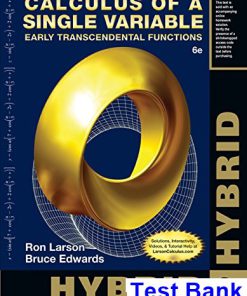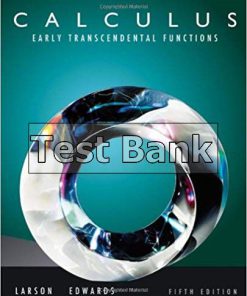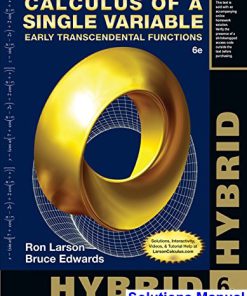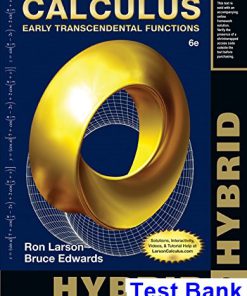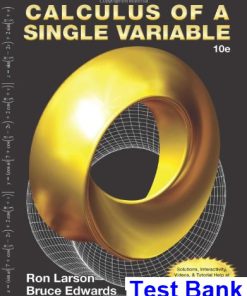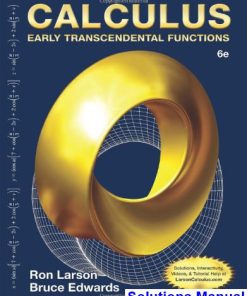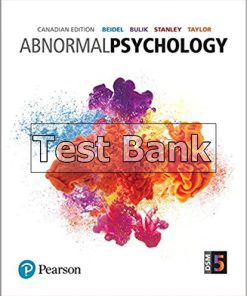Calculus of a Single Variable Early Transcendental Functions 6th Edition Larson Test Bank
$26.50$50.00 (-47%)
Calculus of a Single Variable Early Transcendental Functions 6th Edition Larson Test Bank.
You may also like
Calculus of a Single Variable Early Transcendental Functions 6th Edition Larson Test Bank
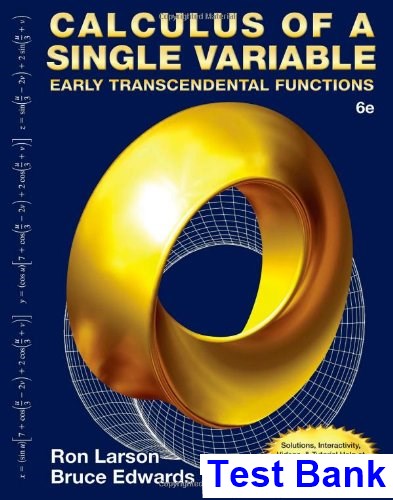
Product details:
- ISBN-10 : 1285774795
- ISBN-13 : 978-1285774794
- Author: Dr Ron Larson
CALCULUS OF A SINGLE VARIABLE: EARLY TRANSCENDENTAL FUNCTIONS, Sixth Edition, offers students innovative learning resources. Every edition from the first to the sixth of CALCULUS: EARLY TRANSCENDENTAL FUNCTIONS has made the mastery of traditional calculus skills a priority, while embracing the best features of new technology and, when appropriate, calculus reform ideas.
Table contents:
- Chapter 1: Preparation for Calculus
- 1.1: Graphs and Models (57)
- 1.2: Linear Models and Rates of Change (64)
- 1.3: Functions and Their Graphs (65)
- 1.4: Fitting Models to Data (21)
- 1.5: Inverse Functions (59)
- 1.6: Exponential and Logarithmic Functions (61)
- 1: Review Exercises
- 1: Problem Solving
- Chapter 2: Limits and Their Properties
- 2.1: A Preview of Calculus (22)
- 2.2: Finding Limits Graphically and Numerically (58)
- 2.3: Evaluating Limits Analytically (65)
- 2.4: Continuity and One-Sided Limits (61)
- 2.5: Infinite Limits (54)
- 2: Review Exercises
- 2: Problem Solving
- Chapter 3: Differentiation
- 3.1: The Derivative and the Tangent Line Problem (54)
- 3.2: Basic Differentiation Rules and Rates of Change (71)
- 3.3: Product and Quotient Rules and Higher-Order Derivatives (81)
- 3.4: The Chain Rule (103)
- 3.5: Implicit Differentiation (63)
- 3.6: Derivatives of Inverse Functions (49)
- 3.7: Related Rates (50)
- 3.8: Newton’s Method (48)
- 3: Review Exercises
- 3: Problem Solving
- Chapter 4: Applications of Differentiation
- 4.1: Extrema on an Interval (55)
- 4.2: Rolle’s Theorem and the Mean Value Theorem (55)
- 4.3: Increasing and Decreasing Functions and the First Derivative Test (70)
- 4.4: Concavity and the Second Derivative Test (59)
- 4.5: Limits at Infinity (68)
- 4.6: A Summary of Curve Sketching (53)
- 4.7: Optimization Problems (58)
- 4.8: Differentials (44)
- 4: Review Exercises
- 4: Problem Solving
- Chapter 5: Integration
- 5.1: Antiderivatives and Indefinite Integration (69)
- 5.2: Area (64)
- 5.3: Riemann Sums and Definite Integrals (64)
- 5.4: The Fundamental Theorem of Calculus (99)
- 5.5: Integration by Substitution (73)
- 5.6: Numerical Integration (57)
- 5.7: The Natural Logarithmic Function: Integration (85)
- 5.8: Inverse Trigonometric Functions: Integration (76)
- 5.9: Hyperbolic Functions (77)
- 5: Review Exercises
- 5: Problem Solving
- Chapter 6: Differential Equations
- 6.1: Slope Fields and Euler’s Method (69)
- 6.2: Differential Equations: Growth and Decay (66)
- 6.3: Differential Equations: Separation of Variables (84)
- 6.4: The Logistic Equation (37)
- 6.5: First-Order Linear Differential Equations (70)
- 6.6: Predator-Prey Differential Equations (20)
- 6: Review Exercises
- 6: Problem Solving
- Chapter 7: Applications of Integration
- 7.1: Area of a Region Between Two Curves (67)
- 7.2: Volume: The Disk Method (67)
- 7.3: Volume: The Shell Method (41)
- 7.4: Arc Length and Surfaces of Revolution (61)
- 7.5: Work (36)
- 7.6: Moments, Centers of Mass, and Centroids (52)
- 7.7: Fluid Pressure and Fluid Force (22)
- 7: Review Exercises
- 7: Problem Solving
- Chapter 8: Integration Techniques, L’Hôpital’s Rule, and Improper Integrals
- 8.1: Basic Integration Rules (52)
- 8.2: Integration by Parts (61)
- 8.3: Trigonometric Integrals (51)
- 8.4: Trigonometric Substitution (51)
- 8.5: Partial Fractions (41)
- 8.6: Integration by Tables and Other Integration Techniques (51)
- 8.7: Indeterminate Forms and L’Hôpital’s Rule (70)
- 8.8: Improper Integrals (70)
- 8: Review Exercises
- 8: Problem Solving
- Chapter 9: Infinite Series
- 9.1: Sequences (39)
- 9.2: Series and Convergence (46)
- 9.3: The Integral Test and p-Series (33)
- 9.4: Comparisons of Series (32)
- 9.5: Alternating Series (36)
- 9.6: The Ratio and Root Tests (47)
- 9.7: Taylor Polynomials and Approximations (36)
- 9.8: Power Series (39)
- 9.9: Representation of Functions by Power Series (37)
- 9.10: Taylor and Maclaurin Series (46)
- 9: Review Exercises
- 9: Problem Solving
- Chapter 10: Conics, Parametric Equations, and Polar Coordinates
- 10.1: Conics and Calculus (46)
- 10.2: Plane Curves and Parametric Equations (43)
- 10.3: Parametric Equations and Calculus (53)
- 10.4: Polar Coordinates and Polar Graphs (56)
- 10.5: Area and Arc Length in Polar Coordinates (54)
- 10.6: Polar Equations of Conics and Kepler’s Laws (38)
- 10: Review Exercises
- 10: Problem Solving
- Chapter 11: Vectors and the Geometry of Space
- 11.1: Vectors in the Plane (49)
- 11.2: Space Coordinates and Vectors in Space (59)
- 11.3: The Dot Product of Two Vectors (44)
- 11.4: The Cross Product of Two Vectors in Space (40)
- 11.5: Lines and Planes in Space (59)
- 11.6: Surfaces in Space (39)
- 11.7: Cylindrical and Spherical Coordinates (57)
- 11: Review Exercises
- 11: Problem Solving
- Chapter 12: Vector-Valued Functions
- 12.1: Vector-Valued Functions (45)
- 12.2: Differentiation and Integration of Vector-Valued Functions (46)
- 12.3: Velocity and Acceleration (42)
- 12.4: Tangent Vectors and Normal Vectors (49)
- 12.5: Arc Length and Curvature (49)
- 12: Review Exercises
- 12: Problem Solving
- Chapter 13: Functions of Several Variables
- 13.1: Introduction to Functions of Several Variables (42)
- 13.2: Limits and Continuity (41)
- 13.3: Partial Derivatives (63)
- 13.4: Differentials (41)
- 13.5: Chain Rules for Functions of Several Variables (37)
- 13.6: Directional Derivatives and Gradients (45)
- 13.7: Tangent Planes and Normal Lines (35)
- 13.8: Extrema of Functions of Two Variables (48)
- 13.9: Applications of Extrema (44)
- 13.10: Lagrange Multipliers (44)
- 13: Review Exercises
- 13: Problem Solving
- Chapter 14: Multiple Integration
- 14.1: Iterated Integrals and Area in the Plane (62)
- 14.2: Double Integrals and Volume (49)
- 14.3: Change of Variables: Polar Coordinates (46)
- 14.4: Center of Mass and Moments of Inertia (42)
- 14.5: Surface Area (34)
- 14.6: Triple Integrals and Applications (46)
- 14.7: Triple Integrals in Other Coordinates (42)
- 14.8: Change of Variables: Jacobians (42)
- 14: Review Exercises
- 14: Problem Solving
- Chapter 15: Vector Analysis
- 15.1: Vector Fields (47)
- 15.2: Line Integrals (46)
- 15.3: Conservative Vector Fields and Independence of Path (40)
- 15.4: Green’s Theorem (40)
- 15.5: Parametric Surfaces (43)
- 15.6: Surface Integrals (43)
- 15.7: Divergence Theorem (29)
- 15.8: Stokes’s Theorem (32)
- 15: Review Exercises
- 15: Problem Solving
- Chapter 16: Additional Topics in Differential Equations (online only)
- 16.1: Exact First-Order Equations (48)
- 16.2: Second-Order Homogeneous Linear Equations (45)
- 16.3: Second-Order Nonhomogeneous Linear Equations (42)
- 16.4: Series Solutions of Differential Equations (27)
- Chapter A: Appendices
- A.A: Proofs of Selected Theorems
- A.B: Integration Tables
- A.C: Precalculus Review (Web)*
- A.D: Rotation and the General Second-Degree Equation (Web)*
- A.E: Complex Numbers (Web)*
- A.F: Business and Economic Applications (Web)*
- Chapter QP: Quick Prep Topics
- QP.1: Definition and Representations of Functions (15)
- QP.2: Working with Representations of Functions (16)
- QP.3: Function Notation (15)
- QP.4: Domain and Range of a Function (14)
- QP.5: Solving Linear Equations (16)
- QP.6: Linear Functions (17)
- QP.7: Parabolas (15)
- QP.8: Factoring Quadratic Equations and Finding x-intercepts of a Quadratic Function (14)
- QP.9: Polynomials (19)
- QP.10: More about Factoring Polynomials (14)
- QP.11: Finding Roots (16)
- QP.12: Dividing Polynomials (16)
- QP.13: Rational Functions (21)
- QP.14: Root Functions (17)
- QP.15: Rationalizing the Numerator or Denominator (13)
- QP.16: Exponential Functions (15)
- QP.17: Logarithmic Functions (17)
- QP.18: Trigonometric Functions and the Unit Circle (17)
- QP.19: Graphs of Trigonometric Functions (17)
- QP.20: Trigonometric Identities (20)
- QP.21: Special Functions (14)
- QP.22: Algebraic Combinations of Functions (16)
- QP.23: Composition of Functions (15)
- QP.24: Transformations of Functions (14)
- QP.25: Inverse Functions (19)
People also search:
calculus of a single variable early transcendental functions 6th edition
calculus of a single variable early transcendental functions 6e answers
calculus of a single variable early transcendental functions 6e pdf
calculus of a single variable early transcendental functions 6e
calculus of a single variable early transcendental functions 6e free pdf

